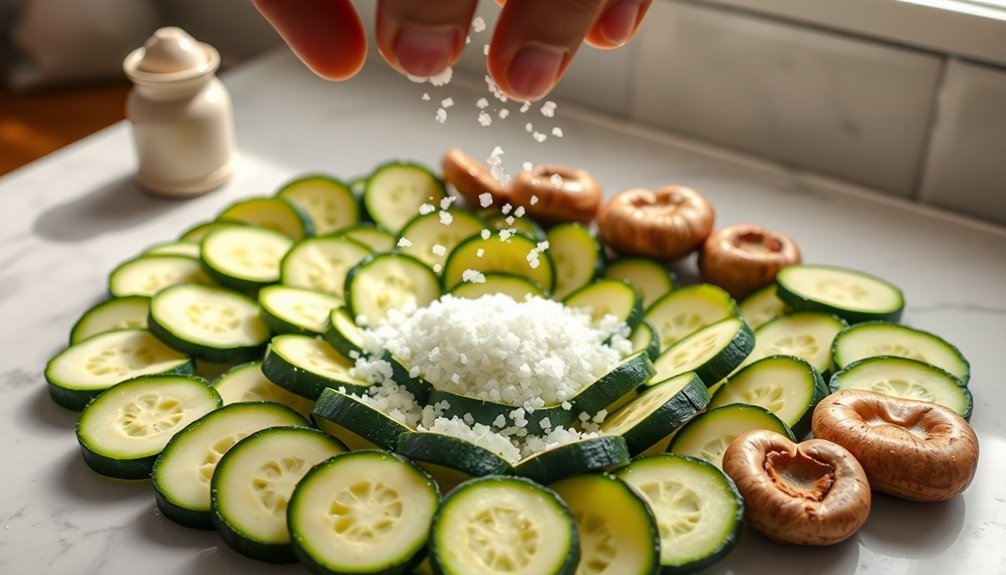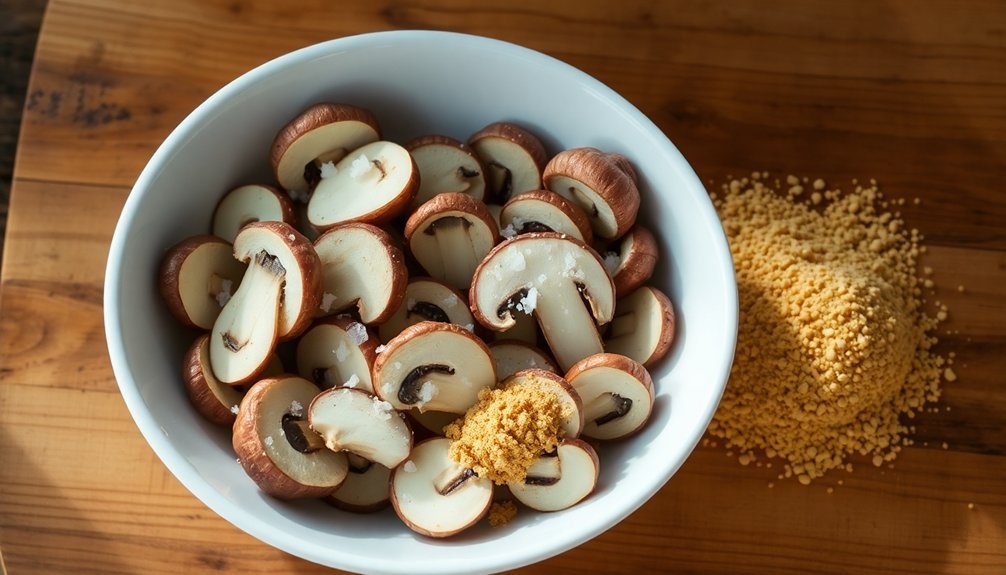For the best dehydrated vegetables, you'll want to use one of five proven salting methods. You can pre-salt and chill grated veggies for two days, soak them in a saltwater solution for quick bacteria elimination, or apply salt directly to cut pieces. Root vegetables benefit from salt curing, which draws out moisture while preserving flavors. For an innovative approach, try creating mushroom powder salt blends that add umami depth to your dried goods. Each method enhances flavor, improves texture, and extends shelf life – and the specific techniques for each approach will help you master vegetable dehydration like a pro.
Pre-Salt and Chill Method

The Pre-Salt and Chill Method transforms root vegetables into concentrated, flavorful powders through a simple but effective process.
You'll start by grating your chosen root vegetables, such as carrots, beets, or parsnips, then thoroughly mix them with salt. This process helps create healthier flavor enhancers compared to traditional table salt.
Place this mixture in a ziploc bag and refrigerate it for two days.
During the chilling period, the salt draws out moisture through osmosis, concentrating the vegetables' flavors and creating a texture that's ideal for dehydrating.
After two days, spread your salted vegetable mixture on a dehydrator tray lined with heavy-duty cling wrap or a fruit leather sheet.
Set your dehydrator to 125 degrees Fahrenheit and let it run overnight or until the vegetables become brittle.
Once your vegetables are completely dry, you'll need to process them into a powder.
Transfer the dehydrated vegetables to a food processor and blend until you've achieved a fine powder consistency.
Store your vegetable powder in an airtight container, keeping it in a cool, dark place.
You can now use this concentrated seasoning to add depth and flavor to your favorite dishes.
Simple Saltwater Soak
Soaking your vegetables in saltwater offers a straightforward yet effective method to prepare them for dehydration. This technique helps kill harmful bacteria and fungi while reducing the overall microbial load on your produce. You'll need just one tablespoon of salt per gallon of water to create an effective solution that'll extend your vegetables' shelf life. The solution works by pulling water out from vegetable cells, creating an environment hostile to microorganisms.
- Start by submerging your vegetables in the saltwater solution for 5-10 minutes.
- Rinse them thoroughly with fresh water to remove any residual salt.
- Pat them completely dry before proceeding with dehydration.
This method works particularly well for delicate produce like berries, leafy greens, cucumbers, and tomatoes. You'll find it's especially useful for vegetables that tend to spoil quickly or develop mold.
After the soak, make sure you're drying your vegetables thoroughly to remove any excess moisture – this is essential for successful dehydration later. If you're not planning to dehydrate immediately, store your treated vegetables in a sealed container to maintain their freshness.
The saltwater soak isn't just a preparatory step; it's an investment in the quality and safety of your dehydrated products.
Direct Salt Application

Direct application of salt offers a more concentrated approach than saltwater soaking for preparing vegetables before dehydration.
You'll want to start by selecting high-water-content vegetables and cutting them uniformly to guarantee even drying. After washing, slice or grate your vegetables to maximize the surface area, then pat them dry with paper towels. This technique is particularly effective because osmotic pressure draws moisture from food cells efficiently.
When applying salt, you'll need to use a generous amount of kosher or coarse salt, guaranteeing even coverage across all vegetable surfaces. Let your salted vegetables sit for 30 minutes to several hours, allowing osmosis to draw out excess moisture. This process won't just remove water; it'll also concentrate flavors and help prevent bacterial growth during dehydration.
Once you've completed the salting process, place your vegetables in a dehydrator or oven at 125°F to 135°F for 6 to 12 hours. You'll know they're ready when they're completely dry and hard to the touch.
Store your dehydrated vegetables in airtight containers in a cool, dark place. When you're ready to use them, simply rehydrate by soaking in water or adding directly to soups and stews.
Salt Curing Root Vegetables
Root vegetables present unique challenges when preparing them for dehydration, but salt curing offers an effective solution. You'll find that proper salt curing not only reduces moisture content but also helps prevent microbial growth during the dehydration process, ensuring your vegetables stay fresh and safe.
- Start by soaking your root vegetables in a saltwater solution, which helps eliminate surface bacteria and fungi. After soaking, rinse them thoroughly with fresh water to remove excess salt.
- Store your salted vegetables in a cool, dry area, wrapping items like potatoes in paper towels or cloth. You can also pack them in a layer of salt for extended storage before dehydration.
- Let the vegetables sit for several hours after salting before placing them in your dehydrator at 125°F until they're completely dry and brittle.
When you're ready to store your dehydrated vegetables, place them in clean, airtight containers and keep them in a cool, dark location.
This method will preserve both flavor and nutritional value for months. Remember to check that your storage area remains moisture-free to prevent any unwanted rehydration or spoilage of your preserved vegetables.
Mushroom Powder Salt Blend

Creating a versatile mushroom powder salt blend adds depth and umami to your dehydrated vegetable preparations.
To start, you'll need to properly dehydrate your mushrooms at 54°C for 4-8 hours, ensuring they're completely dry but still slightly bendy. Don't wash the mushrooms with water; instead, clean them by gently brushing or wiping with a kitchen towel.
Once you've dehydrated your mushrooms, transform them into powder using a food processor or blender. Start at a lower speed to prevent dust, then increase gradually until you achieve a fine powder consistency.
Let the powder cool completely before mixing it with sea salt. You can customize your blend by incorporating additional spices like garlic powder, black pepper, or paprika.
For a smoky variation, try adding chipotle powder to your mushroom salt mixture. You'll want to keep your base mushroom powder separate from your seasoned blends, allowing you to create different flavor combinations as needed.
Store your finished mushroom salt blend in an airtight glass container in your pantry, and use it within three months for ideal flavor and freshness.
Frequently Asked Questions
Can I Use Different Types of Salt for Dehydrating Vegetables?
Yes, you can use any type of salt when dehydrating vegetables. Whether it's table salt, sea salt, or kosher salt, they're all compatible. Your choice will mainly affect the final flavor and texture.
How Do I Adjust Salt Levels for People on Sodium-Restricted Diets?
You'll want to minimize salt use by choosing naturally low-sodium vegetables, using herbs and spices instead. Rinse vegetables thoroughly after dehydrating and consider skipping salt entirely if you're on a strict sodium-restricted diet.
Will Salting Affect the Vitamin Content of My Dehydrated Vegetables?
Your vegetables' vitamin content won't be considerably affected by salting. While you'll lose some water-soluble vitamins during dehydration and rehydration, it's the drying process, not the salt, that impacts nutrient levels.
Can I Mix Different Vegetables When Using the Same Salting Method?
Yes, you can mix different vegetables when using the same salting method, but guarantee they're similar in size and water content. It's best to group vegetables with comparable textures to achieve even salting results.
Should I Adjust Salt Quantities Based on Vegetable Thickness or Water Content?
You don't need to adjust salt based on thickness, but you should consider water content. Follow the recommended salt percentages for each vegetable type: 2% for most vegetables, 3-4% for cucumbers and peppers.
In Summary
You've now learned five effective ways to salt vegetables before dehydrating them. Whether you choose the pre-salt and chill method for tender produce, opt for a saltwater soak with firm vegetables, or try the specialized techniques for mushrooms and root vegetables, you'll achieve better flavor and texture. Choose the method that works best for your specific vegetables and don't forget that proper salting will greatly improve your final dried product.





Leave a Reply